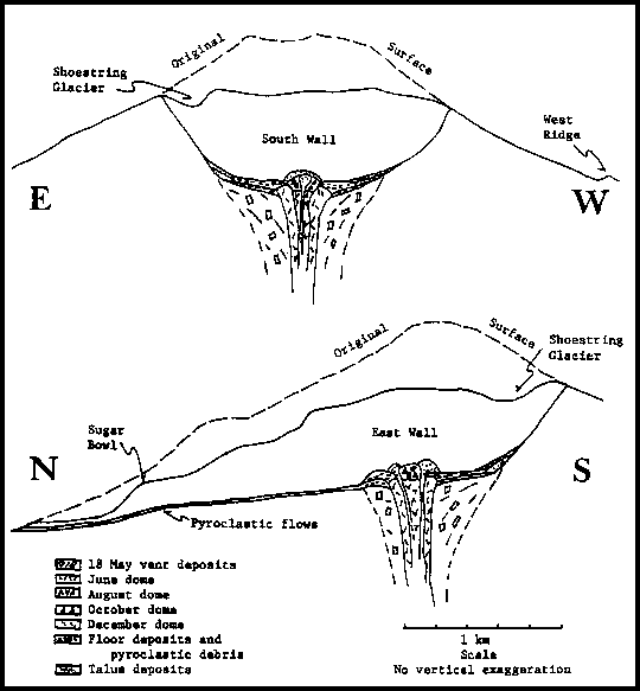Report on St. Helens (United States) — January 1981
Scientific Event Alert Network Bulletin, vol. 6, no. 1 (January 1981)
Managing Editor: Lindsay McClelland.
St. Helens (United States) Dome growth and seismicity; small vapor plumes
Please cite this report as:
Global Volcanism Program, 1981. Report on St. Helens (United States) (McClelland, L., ed.). Scientific Event Alert Network Bulletin, 6:1. Smithsonian Institution. https://doi.org/10.5479/si.GVP.SEAN198101-321050
St. Helens
United States
46.2°N, 122.18°W; summit elev. 2549 m
All times are local (unless otherwise noted)
Lava extrusion resumed 5 February, adding a substantial quantity of new material to the dome that grew in the crater after the 16-18 October explosions and the two new lobes produced in late December and early January (figure 14).
 |
Figure 14. E-W and N-S cross sections through Mt. St. Helens, January 1981, by Michael Doukas, USGS. |
Minor activity — January. After growth of the December-January lobes ceased between 2 and 4 January, outward movement of the N crater rampart gradually declined to an average of about 0.5 cm/day, although rates were variable and data were limited. January seismicity was the quietest of any period since earthquakes began 20 March. Only 40 discrete events were large enough to be recorded on three or more stations of the USGS-University of Washington seismic net, in contrast to 136 in December and 74 in November. Of the January earthquakes, about ten were low-frequency events associated with dome growth early in the month, many others were rock avalanche events, and a few accompanied ejection of steam plumes. A new fumarole opened on 9 January on the E margin of the lava dome. This fumarole was the probable source of small steam-and-ash plumes on 16 January at 1152 (to 3 km altitude) and 20 January at 1204 (to at least 3 km), both accompanied by bursts of seismicity. Similar seismic activity was recorded 24-25 January and field parties saw light ash deposits on fresh snow. Several similar bursts occurred 31 January-1 February, two of which could be correlated with steam-and-ash emission. However, another steam plume was ejected without accompanying seismicity.
Increased deformation and seismicity. Deformation and seismic activity began to increase at the beginning of February. Radial fissures in the crater floor began to widen at a noticeably faster rate and movement of thrust faults accelerated. A larger number of glowing cracks in the surface of the lava dome indicated that its temperature was increasing. On 2 February at 0336, a 4-minute burst of seismicity was followed by a M 2 earthquake at 0340, then low-level harmonic tremor were recorded until 0630. Occasional bursts of seismic activity continued through the day, and 35 minutes of low-level tremor was recorded that night. A gradual increase in discrete earthquakes began 3 February. Occasional low-level tremor was recorded, as were several bursts of seismicity, one of which was associated with a small plume at 1220. By midnight 4-5 February, the number of discrete events had reached 4-5/hour and continued at that rate for about 6 hours.
Lava extrusion. Just before 0500, the USGS and University of Washington issued an advisory predicting an eruption within the next 12 hours. Seismicity began to decline about 0600, probably signaling the beginning of lava extrusion. By 0800, earthquakes were occurring at a rate of only about 1/hr. Very heavy steaming obscured the crater, but new lava could be seen on the October dome during about 30 seconds of visibility. The number of discrete seismic events decreased further by mid-afternoon, remaining at many fewer than 1/hr through 8 February. However, bursts of unusual seismic signals were recorded, possibly caused by lava extrusion.
Improved visibility revealed that the new lava was extruded through the collapse pit in the center of the October dome. The new material appeared to have both uplifted and overridden the October dome, leaving this area about 35 m higher by the time growth apparently stopped during the night of 6-7 February. The small NW lobe emplaced during the December-January activity was pushed about 12 m N and partially overridden by new lava. New thrust faulting also occurred in the SW part of the crater, but was much less extensive than the thrusting associated with the December-January activity. The increase in dome volume produced by the February extrusion was roughly equal to the volume of lava produced by each of the two previous events, but at press time it was not possible to determine how much volume was of new lava on the surface and how much was caused by uplift of pre-existing lobes.
Geological Summary. Prior to 1980, Mount St. Helens was a conical volcano sometimes known as the Fujisan of America. During the 1980 eruption the upper 400 m of the summit was removed by slope failure, leaving a 2 x 3.5 km breached crater now partially filled by a lava dome. There have been nine major eruptive periods beginning about 40-50,000 years ago, and it has been the most active volcano in the Cascade Range during the Holocene. Prior to 2,200 years ago, tephra, lava domes, and pyroclastic flows were erupted, forming the older edifice, but few lava flows extended beyond the base of the volcano. The modern edifice consists of basaltic as well as andesitic and dacitic products from summit and flank vents. Eruptions in the 19th century originated from the Goat Rocks area on the N flank, and were witnessed by early settlers.
Information Contacts: D. Swanson, C. Newhall, J. Dvorak, USGS, Vancouver, WA; S. Malone, C. Boyko, E. Endo, C. Weaver, University of Washington; R. Tilling, USGS, Reston, VA.

